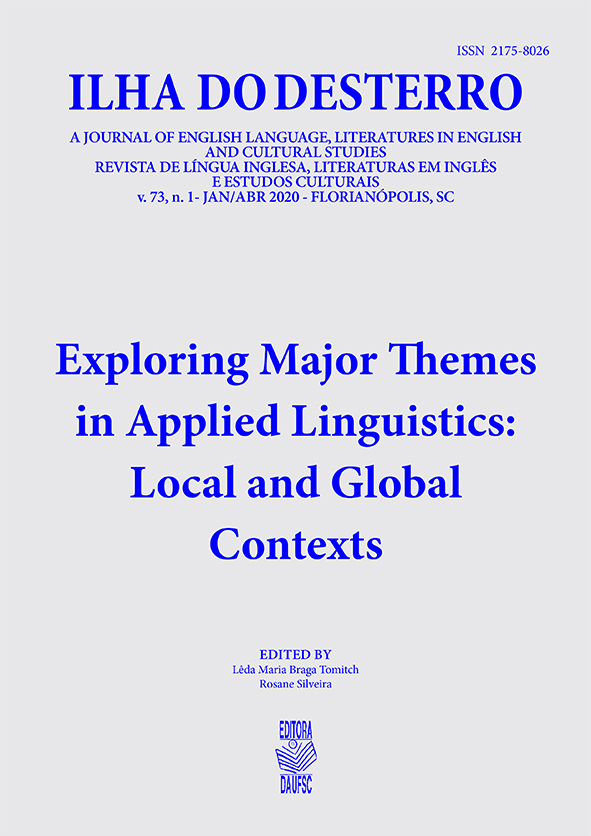A conceptual approach to the –ING construction: aspects of radiality and subjectification
DOI:
https://doi.org/10.5007/2175-8026.2020v73n1p443Abstract
The –ING construction has a number of uses in the English language and teaching it to speakers of other languages poses some challenges, as learners tend to interpret the construction as a verbal one, in the progressive aspect, which is only one part of the picture. Bearing this in mind, we have developed a corpus-based research into the form-meaning/function pairing (Goldberg, 1995, 2006) of the construction, relying on Construction Grammar (Fillmore; Kay, 1999; Goldberg, 1995, 2006) and Cognitive Grammar (Langacker, 1987, 1990, 1991, 2008), apart from a semantic approach to the –ING construction (Wierzbicka, 1988), essential for describing the –ING construction from a conceptual perspective within the wide-ranging scope of Cognitive Linguistics (Geeraerts, 2006), which also included Prototype Theory (Rosch, 1973) and Radial Categories (Brugman, 1981; Lakoff, 1987). In regard to methodology, we have taken both a quantitative and qualitative approach to data (Cook; Reichardt, 1979; Richardson, 1985; Creswell, 2010) compiled from an English/Spanish parallel corpus of 1199 verbal –ING occurrences. Our main hypothesis is that the –ING construction, in its verbal function, is more central or prototypical (Rosch, 1973; Brugman, 1981; Lakoff, 1987; Langacker, 2008) in respect to its conceptual network and its other functions, namely nominal, adjectival and adverbial. These functions, in turn, exhibit a more peripheral role and are linked to the verbal function through metaphorical extension relationships (Goldberg, 1995, 2006). By performing a corpus-based analysis of the data (Berber-Sardinha, 2002, 2004) we finally argue that there is a radial organisation (Brugman, 1981; Lakoff, 1987) for the –ING construction, which goes from a more concrete level, being this more situated or grounded and thus more objectified (as a “here and now process”), until it gets to a more abstract level, therefore, less situated and more subjectified (taken as a “thing”).
References
BIBER, D.; CONRAD, S.; LEECH, G. (2002). Longman Student Grammar of Spoken and Written English. Harlow, Essex, England: Pearson Education Limited.
BRUGMAN, C. (1981) The Story of Over. MA Thesis, University of California, Berkeley.
BRUGMAN, C; LAKOFF, G. (2006).Cognitive topology and lexical networks. In: GEERAERTS, D. (ed.) Cognitive Linguistics: Basic Readings. Berlin: Mouton de Gruyter (The Hague), p. 109-138.
COLEMAN, L.; KAY, P. (1981)."Prototype Semantics: The English Word Lie." Language 57. University of California, Berkeley, p. 26-44.
COOK, T. D.; REICHARDT, C. S. (ed.). (1979).Qualitative and Quantitative Methods in Evaluation. Londres: Sage.
CRESWELL, J. W. (2010). Projeto de Pesquisa: Método Quantitativo, Qualitativo e Misto. São Paulo: Bookman Companhia Editora.
ECKERSLEY & ECKERSLEY. (1960).A Comprehensive English Grammar. Harlow: Longman.
FERRARI, L. (2011). Introdução à Linguística Cognitiva. São. Paulo: Contexto.
FILLMORE, C. The case for case. In: BACH, E.; HARMS, R. (eds.) (1968). Universals in Linguistic Theory. New York: Holt Reinhart & Winston, p. 21-29.
FILLMORE, C. (1975). An Alternative to Checklist Theories of Meaning. In: COGEN, C. et al. (ed). Proceedings of the First Annual Meeting of the Berkeley Linguistics Society. Berkeley: Berkeley Linguistics Society, p. 123-131.
GEERAERTS, D. (ed.) (2006). Cognitive Linguistics: Basic Readings. Berlin: Mouton de Gruyter (The Hague).
GOLDBERG, A. (1995). Constructions: A Construction Grammar Approach to Argument Structure. Chicago: University of Chicago Press.
GOLDBERG, A. (2006). Constructions at Work: The Nature of Generalization in Language. New York: OUP.
KAY, P. & FILLMORE, C.J. (1999). Grammatical Constructions and Linguistic Generalizations: the what’s X doing Y? construction. Language 75, p. 1-34.
LAKOFF, G. (1987). Women, Fire and Dangerous Things. Chicago: The University of Chicago Press.
LAKOFF, G; JOHNSON, M. (1980). Metaphors we Live by. Chicago: University Press.
LANGACKER, R. (1987). Foundations of Cognitive Grammar. v. 1: Theoretical Prerequisites. Stanford: Stanford University Press, p. 29-67.
LANGACKER, R. (1990). Subjectification. In: Cognitive Linguistics 1-1, p. 5-38.
LANGACKER, R. (1991). Foundations of Cognitive Grammar v.2.Descriptive Applications. Stanford: Stanford University Press.
LANGACKER, R. Cognitive Grammar. In: GEERAERTS, D. (ed.). (2006). Cognitive Linguistics: Basic Readings. Berlin: Mouton de Gruyter (The Hague).
LANGACKER, R. (2008). Cognitive Grammar: A Basic Introduction. New York: Oxford University Press.
LEECH, G. & SVARTVIK, (1975). J. A Communicative Grammar of English. London: Longman.
QUIRK, R. & GREENBAUM, S. (1973). A University Grammar of English. London: Longman.
RAE. (2010). Nueva gramática de la lengua española. Madrid: Real Academia Espanola; Asociación de Academias de la Lengua Española.
RICHARDSON, R. J. (1985). Pesquisa Social: métodos e técnicas. São Paulo: Atlas.
RICHARDS, J. C.; RENANDYA, W.A. (2002). Methodology in language teaching: an anthology for current practice. Cambridge: Cambridge University Press.
ROSCH, E. (1973). On the Internal Structure of Perceptual and Semantic Categories. In: MOORE, T. (ed.). Cognitive Development and the Acquisition of Language. New York: Academic Press, p. 11-144.
SARDINHA, T. B. (2002). Corpora eletrônicos na pesquisa em tradução. Cadernos de Tradução IX, Tradução e Corpora. Florianópolis: UFSC/NUT, vol.1, p. 15-59.
SARDINHA, T. B. (2004). Lingüística de corpus. Barueri: Manole.
TALMY, Leonard. (2000). Toward a Cognitive Semantics: Concept Structuring Systems, Volume 1, The MIT Press.
WIERZBICKA, A. (1988). The semantics of grammar. Amsterdam/Philadelphia: John Benjamins.




